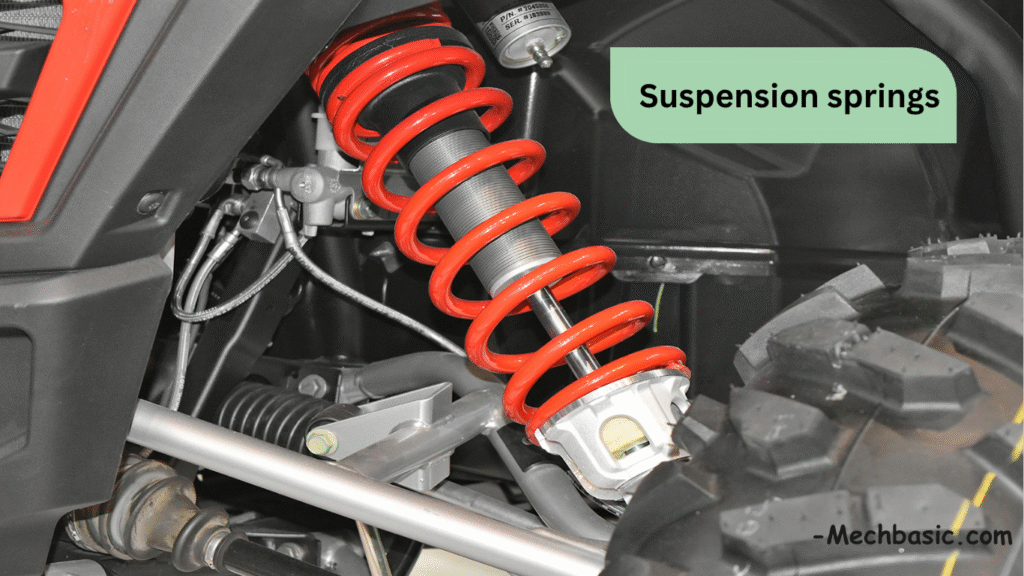Springs are a crucial part of a car’s suspension system, responsible for absorbing road shocks, supporting vehicle weight, and ensuring ride comfort and control. Here’s a detailed explanation of car springs, their types, functions, and working principles:

In this article:
What Are Springs in a Car?
Springs are elastic components in the suspension system that compress and expand to absorb shocks from road irregularities. They help maintain tire contact with the road and provide a smooth ride.
Why do we need suspension springs in cars?
1. Ride Comfort
- Absorb shocks from bumps, potholes, and uneven roads.
- Prevent the impact forces from being transmitted directly to the car’s frame and passengers.
2. Vehicle Control and Stability
- Keep the tires in contact with the road surface.
- Without springs, wheels could lift off the road after hitting bumps, reducing braking and steering control.
3. Load Support
- Support the weight of the vehicle (including passengers, cargo, and the vehicle body itself).
- Help maintain proper ride height and balance under varying loads.
4. Vibration Dampening
- Work with shock absorbers to reduce oscillations (bouncing) that occur when the car hits a bump.
5. Handling and Performance
- Help manage weight transfer during acceleration, braking, and cornering.
- Performance-tuned springs can enhance agility and road grip.
Functions of Springs in a Car
Here’s the simple points describing the main functions of springs in cars.
- Absorb shocks and vibrations
- Support the vehicle’s weight
- Maintain proper ride height
- Keep tires in contact with the road
- Improve passenger comfort and safety
How Springs Work with Shock Absorbers?
Springs store energy when compressed (like hitting a bump) and release it as they return to their original shape. Without shock absorbers (dampers), the car would bounce excessively. The shocks control the spring’s motion, ensuring a smooth ride.
How Springs Work (Step-by-Step)
1. Wheel Hits a Bump or Dip
- The wheel moves upward (compression) or downward (rebound).
2. Spring Compresses or Expands
- The spring compresses to absorb upward motion or extends to accommodate downward movement.
3. Energy Is Stored and Released
- During compression, the spring stores energy.
- As it returns to its original shape, it releases energy smoothly, helping return the suspension to its normal position.
4. Shock Absorber Controls Motion
- The spring works with a shock absorber (damper) to prevent continuous bouncing.
Types of Springs in Cars
For more detailed explanation(with diagram) of types of springs please check the following link
Also read : Types of springs in cars.
1. Coil Spring (Helical Spring)
- Shape: Spiral coil of steel.
- Common Use: Most modern cars (especially front suspension).
- Pros: Compact, simple, cost-effective.
- Cons: Can be stiff without proper damping.
🔄 Working: Compresses vertically when a load is applied, then expands when the load is removed.
2. Leaf Spring
- Shape: Multiple flat, flexible metal strips stacked together.
- Common Use: Trucks, SUVs, rear axle of older vehicles.
- Pros: Handles heavy loads, durable.
- Cons: Less comfortable, bulkier.
🔄 Working: Flexes under load, distributing weight across the axle.
3. Torsion Bar Spring
- Shape: Long metal bar that twists.
- Common Use: Trucks, off-road vehicles, older European cars.
- Pros: Adjustable ride height, compact.
- Cons: Limited travel, less common now.
🔄 Working: One end is fixed; the other twists to absorb vertical motion.
4. Air Spring (Air Suspension)
- Shape: Rubber bellows filled with compressed air.
- Common Use: Luxury vehicles, buses, performance cars.
- Pros: Adjustable stiffness and height, very smooth ride.
- Cons: Expensive, complex, requires air compressor system.
🔄 Working: Air pressure changes inside the chamber to adjust support and damping.
5. Hydropneumatic / Hydraulic Springs
- Used In: High-end and specialty cars (e.g., Citroën, Rolls-Royce).
- Uses liquid and gas to support the car and absorb shocks.
- Can self-level and offer variable damping.
Comparison Table:
| Spring Type | Ride Comfort | Load Handling | Common Use | Adjustability |
|---|---|---|---|---|
| Coil Spring | Moderate to High | Moderate | Most passenger cars | No |
| Leaf Spring | Low to Moderate | High | Trucks, SUVs | No |
| Torsion Bar | Moderate | Moderate | Older trucks, SUVs | Yes (some) |
| Air Spring | High | Moderate to High | Luxury/performance cars | Yes |
| Hydraulic Spring | Very High | Moderate | Luxury cars | Yes |
Signs of a Failing Spring:
- Uneven ride height
- Vehicle sagging on one side
- Bouncy or rough ride
- Clunking noises over bumps
- Poor handling or cornering
FAQ Section :
- What is the purpose of suspension springs in a car?
Answer: Suspension springs support the vehicle’s weight, absorb road shocks, and help maintain tire contact with the road for better handling and ride comfort.
2. What types of suspension springs are used in vehicles?
Answer: Common types include:
- Coil springs (most common in cars)
- Leaf springs (used in trucks and older vehicles)
- Torsion bars (twist instead of compress)
- Air springs (used in air suspension systems)
3. How do I know if my car’s suspension springs are bad?
Answer: Signs include:
- Sagging or uneven ride height
- Excessive bouncing or bottoming out
- Unusual noises (clunking or creaking)
- Poor handling or increased body roll
4. How long do suspension springs typically last?
Answer: Suspension springs can last 100,000 miles or more, but their lifespan depends on driving conditions, vehicle load, and maintenance.
5. Can I replace just one spring, or should I do both sides?
Answer: It’s recommended to replace springs in pairs (left and right) to maintain balance and consistent ride height.
6. What’s the difference between springs and shock absorbers?
Answer: Springs absorb and store energy, cushioning the vehicle. Shock absorbers control the motion of the springs to prevent excessive bouncing.
7. Do aftermarket or performance springs improve my car?
Answer: Yes, performance springs (e.g., lowering springs) can improve handling and appearance, but they may reduce ride comfort if not matched with proper shocks.
8. Are air springs better than coil springs?
Answer: Air springs offer adjustable ride height and comfort, ideal for luxury or off-road vehicles, but are more complex and expensive than coil springs.
9. Can worn springs damage other suspension components?
Answer: Yes, weak or broken springs can cause uneven tire wear, strain on shocks, poor alignment, and damage to suspension arms or bushings.
10. Is it safe to drive with a broken suspension spring?
Answer: No. A broken spring compromises handling and safety and can cause further damage. It should be repaired immediately.
Related articles:
- What is a suspension system in automobile?
- Types of suspension system in cars.
- How to know if suspension system is bad?
- How to repair car suspension system?
Other courses:



